Cross-cultural indie music projects offer unique opportunities for artistic expression and cultural exchange. These initiatives thrive on diverse collaborations, innovative sounds, and successful success stories. However, they also face challenges like communication barriers and differing artistic visions. Key metrics such as audience reach and engagement levels help assess their impact in promoting understanding across cultures.

What drives the success of cross-cultural indie music projects?
Cross-cultural indie music projects succeed due to diverse collaborations, cultural fusion, and innovative approaches. These projects thrive on unique artistic expressions that resonate with global audiences. Successful examples include collaborations between artists from different backgrounds, which enrich the music with varied influences. The blending of distinct styles creates a fresh sound that attracts listeners. Additionally, leveraging digital platforms enhances visibility and accessibility, allowing these projects to reach wider audiences.
How do collaborations enhance creativity and innovation in music?
Collaborations enhance creativity and innovation in music by merging diverse cultural influences and artistic perspectives. These projects often lead to unique soundscapes and innovative genres. For example, cross-cultural indie music projects allow artists to explore new themes and styles, resulting in fresh musical expressions. Collaborations can also expand an artist’s audience, increasing exposure and opportunities for success.
Which platforms are most effective for promoting cross-cultural music?
Social media platforms like Instagram, TikTok, and YouTube are most effective for promoting cross-cultural music. These platforms enable artists to showcase their work visually and connect with diverse audiences globally. Instagram offers engaging visuals, while TikTok’s short-form videos drive viral trends. YouTube provides a comprehensive space for music videos and collaborations, enhancing reach and impact. Engaging with niche communities on these platforms can result in successful cross-cultural collaborations and increased visibility for indie music projects.
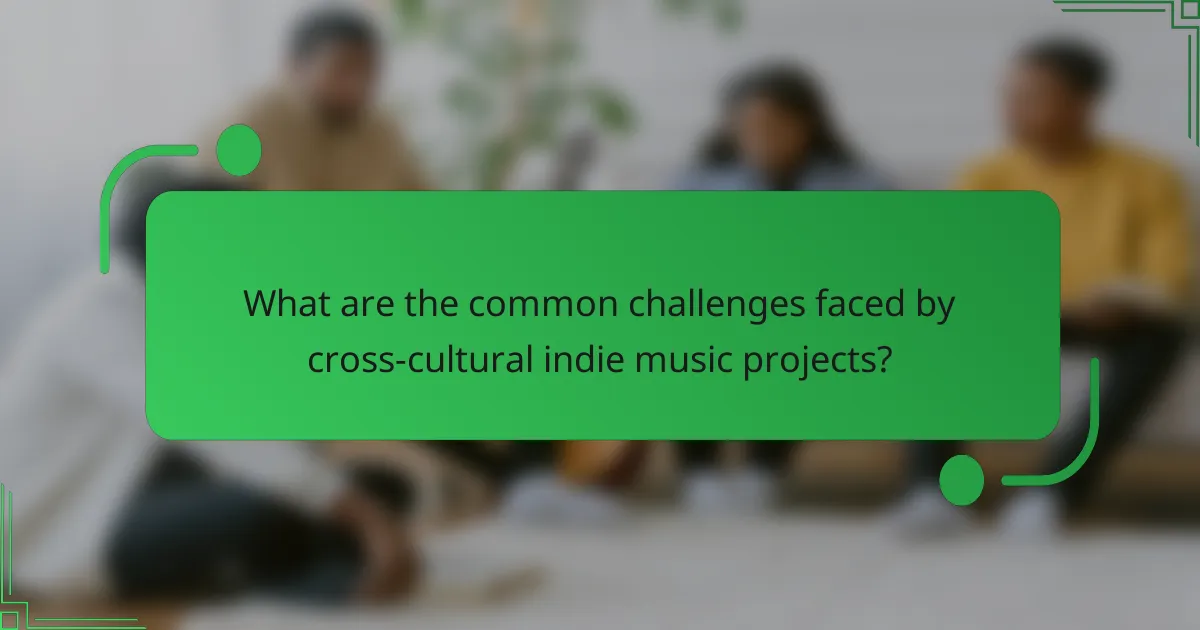
What are the common challenges faced by cross-cultural indie music projects?
Cross-cultural indie music projects often face challenges such as cultural misunderstandings, communication barriers, and differing artistic visions. These issues can hinder collaboration and impact the overall success of the project. Additionally, navigating diverse market dynamics and audience preferences can complicate promotion and distribution efforts. Finally, securing funding and resources for projects that span multiple cultures can prove difficult, limiting opportunities for growth and exposure.
How do cultural differences impact collaboration dynamics?
Cultural differences significantly influence collaboration dynamics in cross-cultural indie music projects. These differences shape communication styles, decision-making processes, and conflict resolution approaches.
For instance, artists from collectivist cultures may prioritize group harmony, while those from individualistic backgrounds might focus on personal expression. This can lead to misunderstandings if not addressed.
Moreover, language barriers can create challenges in conveying artistic visions. Successful collaborations often involve cultural sensitivity and adaptability, fostering an environment of mutual respect.
As a result, projects that embrace cultural diversity can enhance creativity and innovation, leading to unique musical expressions that resonate across different audiences.
What are the financial hurdles for indie artists in cross-cultural projects?
Indie artists face significant financial hurdles in cross-cultural projects, including funding shortages, high production costs, and limited access to distribution channels. These challenges often stem from the need to navigate diverse markets and cultural barriers. Additionally, securing sponsorship or grants can be difficult, as many funding bodies prioritize mainstream artists. As a result, indie musicians may struggle to realize their creative visions while managing financial constraints effectively.
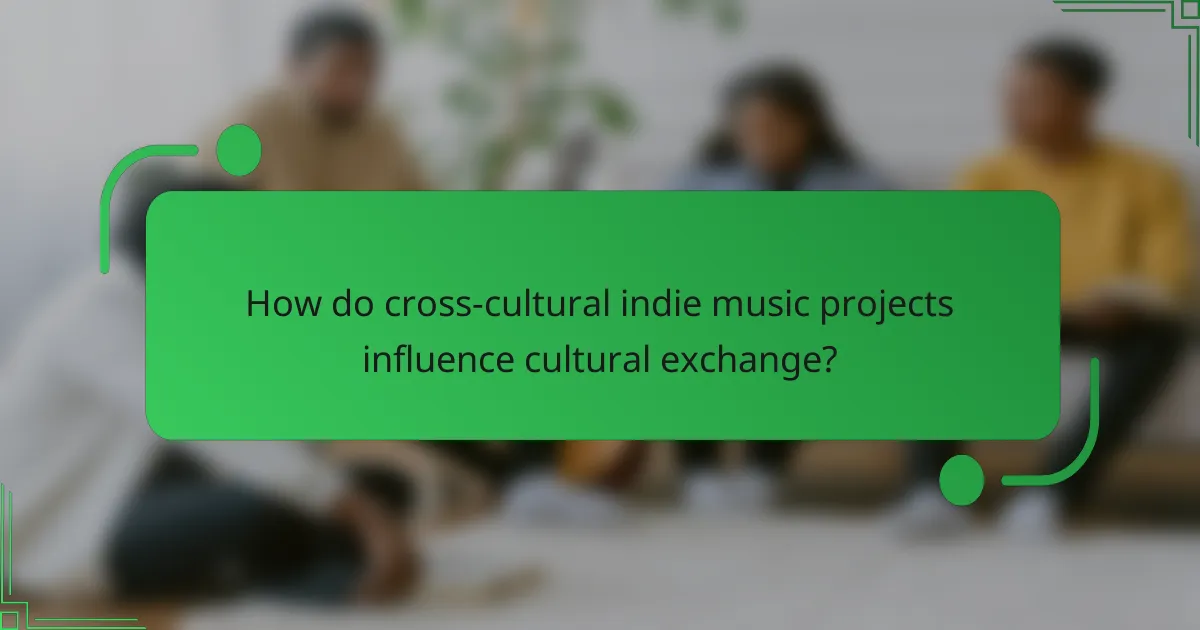
How do cross-cultural indie music projects influence cultural exchange?
Cross-cultural indie music projects significantly enhance cultural exchange by fostering collaboration among diverse artists. These projects blend different musical styles, creating innovative sounds that resonate across borders. They also promote understanding and appreciation of various cultures, encouraging dialogue among communities. Success stories, such as collaborations between artists from different countries, illustrate how music transcends language barriers and unites people through shared experiences.
What role do festivals play in promoting diverse music styles?
Festivals significantly promote diverse music styles by providing platforms for cross-cultural indie music projects. They facilitate collaborations among artists from various backgrounds, enhancing creativity and audience reach. Festivals often showcase unique performances that highlight the fusion of different musical traditions, drawing diverse crowds. As a result, they contribute to the global music landscape, fostering appreciation for varied genres and styles.
Which artists have successfully bridged cultural divides through music?
Several artists have successfully bridged cultural divides through music by creating innovative cross-cultural collaborations. Notable examples include Yo-Yo Ma, who blends classical music with various global traditions, and Anoushka Shankar, who merges Indian classical music with contemporary genres.
Other impactful artists include Tinariwen, a Tuareg band that combines traditional desert blues with modern influences, and the Black Mambas, who fuse African rhythms with Western pop. These collaborations not only celebrate diversity but also foster understanding and connection among different cultures.
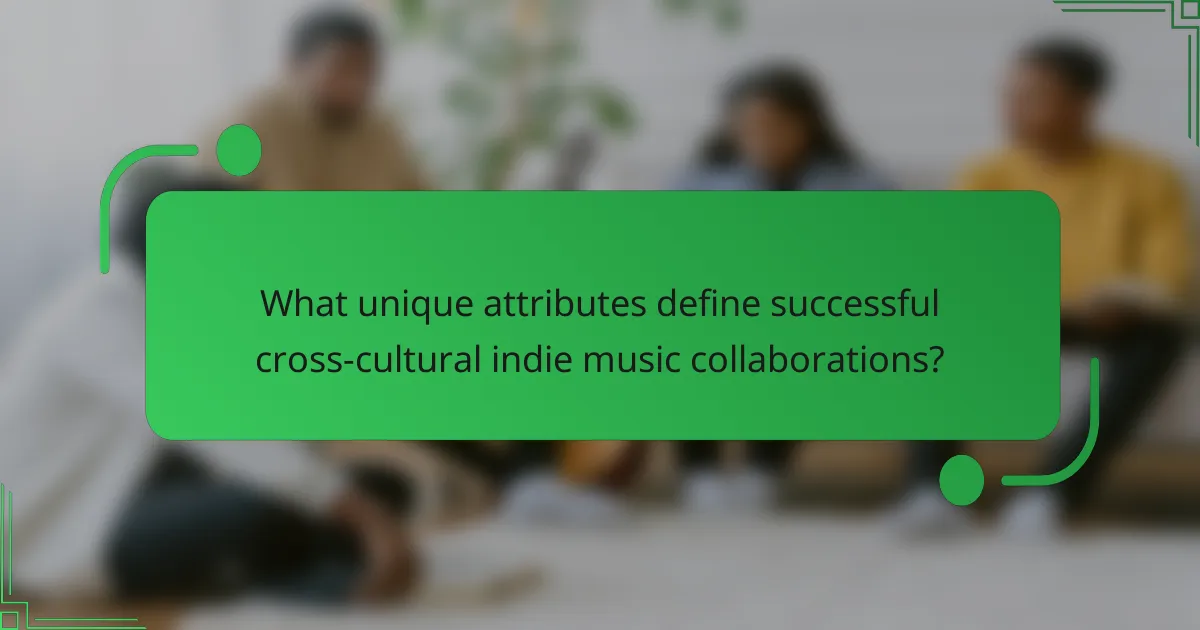
What unique attributes define successful cross-cultural indie music collaborations?
Successful cross-cultural indie music collaborations are defined by shared creativity, cultural exchange, and diverse influences. These projects often blend distinct musical styles, enhancing originality and appeal. Unique attributes include mutual respect among artists, innovative fusion of genres, and storytelling that resonates across cultures. Collaborations like these can lead to broader audiences and enriched artistic expression.
How do genre fusions create new musical landscapes?
Genre fusions create new musical landscapes by blending diverse cultural influences, resulting in innovative sounds. These projects often feature collaborations between artists from different backgrounds, enriching the music with unique attributes. For instance, the combination of traditional instruments with modern electronic elements can lead to fresh auditory experiences. Successful cross-cultural indie music projects highlight the impact of these collaborations, showcasing how they can transcend geographical boundaries and resonate with a global audience. As a result, genre fusions not only expand musical creativity but also foster cultural exchange and understanding.
What are the storytelling techniques that resonate across cultures?
Storytelling techniques that resonate across cultures include universal themes, relatable characters, and emotional connections. These elements foster understanding and engagement in cross-cultural indie music projects.
Universal themes, such as love, struggle, and hope, appear in diverse narratives, making them accessible globally. Relatable characters allow listeners to see themselves in the story, bridging cultural divides. Emotional connections, often achieved through music’s rhythm and melody, evoke shared feelings that transcend language barriers.
Collaborative efforts in cross-cultural indie music often emphasize these storytelling techniques, leading to impactful projects that celebrate diversity and commonality. Success stories highlight how artists from different backgrounds unite through shared narratives, enhancing cultural appreciation and collaboration.
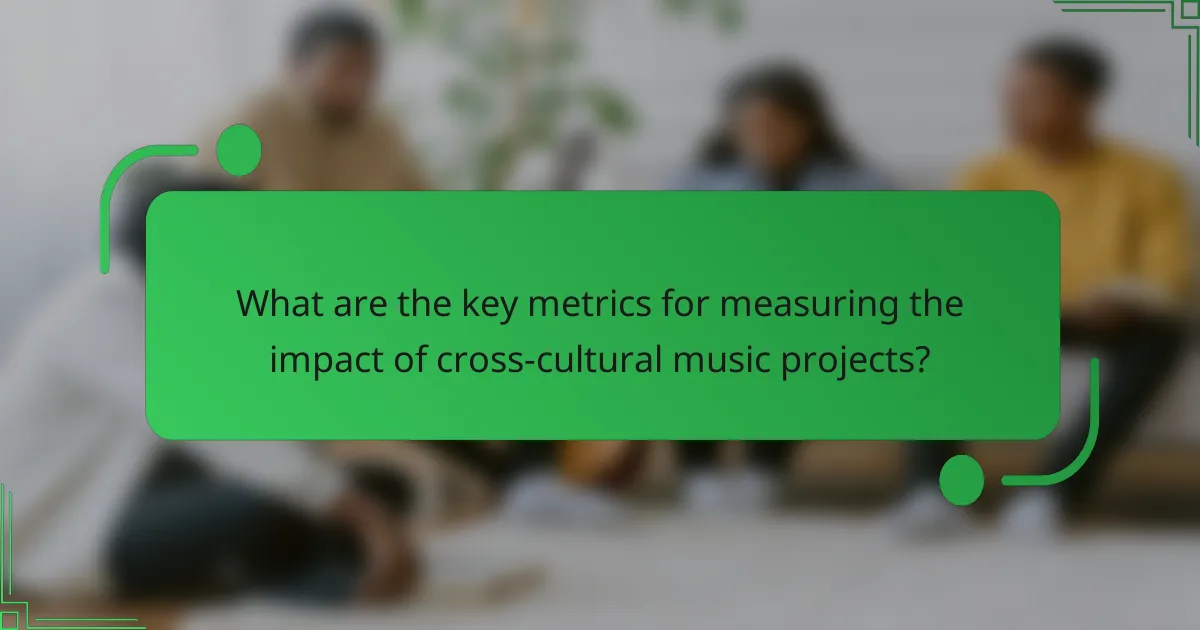
What are the key metrics for measuring the impact of cross-cultural music projects?
Key metrics for measuring the impact of cross-cultural music projects include audience reach, engagement levels, cultural exchange frequency, and collaboration outcomes. These metrics help assess the effectiveness of partnerships and the project’s overall success in promoting cultural understanding.
Metrics | Description
Audience Reach | Number of listeners across different regions
Engagement Levels | Interaction rates on social media and streaming platforms
Cultural Exchange Frequency | Instances of collaboration between artists from different cultures
Collaboration Outcomes | Success stories and new music created from partnerships
Feedback Quality | Audience and artist reviews on cultural impact
Sustainability | Long-term influence on local music scenes
How do audience engagement and feedback vary across regions?
Audience engagement and feedback vary significantly across regions due to cultural preferences and music consumption habits. In Europe, indie music often garners strong community support, leading to higher participation in live events. Conversely, in Asia, digital platforms dominate, resulting in extensive online feedback through social media interactions.
Regional collaborations can enhance audience connection. For instance, projects that blend local sounds with global indie influences tend to resonate well, fostering engagement. Unique attributes, such as language and traditional instruments, play a crucial role in how audiences perceive and respond to indie music.
Statistical data shows that regions with active indie scenes, like North America and parts of Europe, report higher engagement rates compared to emerging markets. This disparity highlights the importance of understanding local contexts for successful cross-cultural projects.
As a result, indie music projects must adapt their strategies to suit regional preferences, ensuring meaningful engagement and feedback from diverse audiences.
What are the indicators of commercial success for indie projects?
Indicators of commercial success for indie projects include audience engagement, revenue generation, and critical acclaim. Successful cross-cultural indie music projects often demonstrate a growing fan base, increased streaming numbers, and positive reviews. Collaborations with diverse artists can enhance visibility and expand market reach. Unique storytelling and cultural authenticity are rare attributes that resonate with listeners, further driving success.
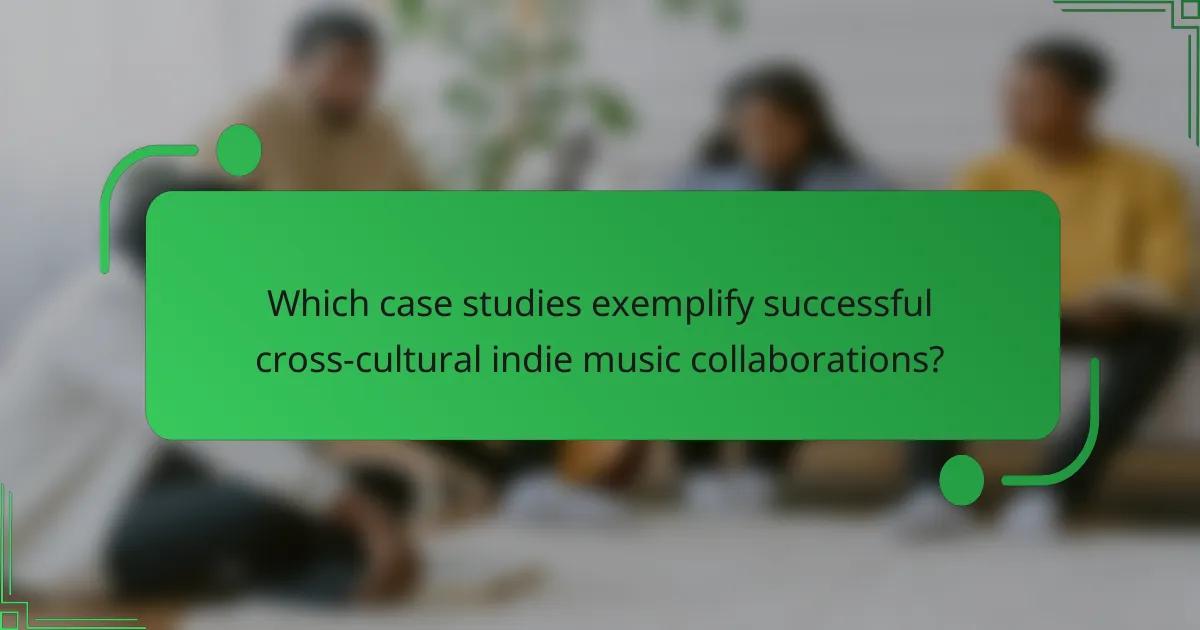
Which case studies exemplify successful cross-cultural indie music collaborations?
Successful cross-cultural indie music collaborations include projects like “Buena Vista Social Club,” which united Cuban musicians, and “The Silk Road Ensemble,” featuring artists from diverse backgrounds. These collaborations highlight the blending of cultural influences and the creation of innovative sounds. For example, “Tinariwen” merges traditional Tuareg music with rock, gaining international acclaim. Such projects demonstrate the power of music to transcend borders and foster understanding among different cultures.
What lessons can be learned from notable projects in Europe?
Notable projects in Europe demonstrate the power of collaboration in cross-cultural indie music. They highlight the importance of blending diverse musical styles, which fosters innovation and broadens audience reach. For instance, the collaboration between artists from different countries often leads to unique soundscapes, enriching the music scene.
These projects reveal that successful partnerships can enhance cultural exchange and create impactful narratives. The fusion of various musical influences not only attracts wider audiences but also promotes understanding among different cultures.
Additionally, lessons learned include the significance of local support and community engagement. Projects that involve local artists and resources tend to resonate more deeply with audiences, creating lasting connections.
Ultimately, these initiatives showcase the potential for indie music to bridge cultural divides, making it a powerful tool for social change and unity.
How have collaborations in North America shaped the indie music scene?
Collaborations in North America have significantly enriched the indie music scene, fostering creativity and diverse sounds. Cross-cultural projects have led to innovative music styles, blending genres and cultural influences. Artists from different backgrounds have come together, resulting in unique collaborations that resonate with wider audiences. For instance, partnerships between Canadian and American indie musicians have produced acclaimed albums that highlight regional sounds while appealing to global listeners. These collaborations not only enhance artistic expression but also strengthen community ties within the indie music landscape.
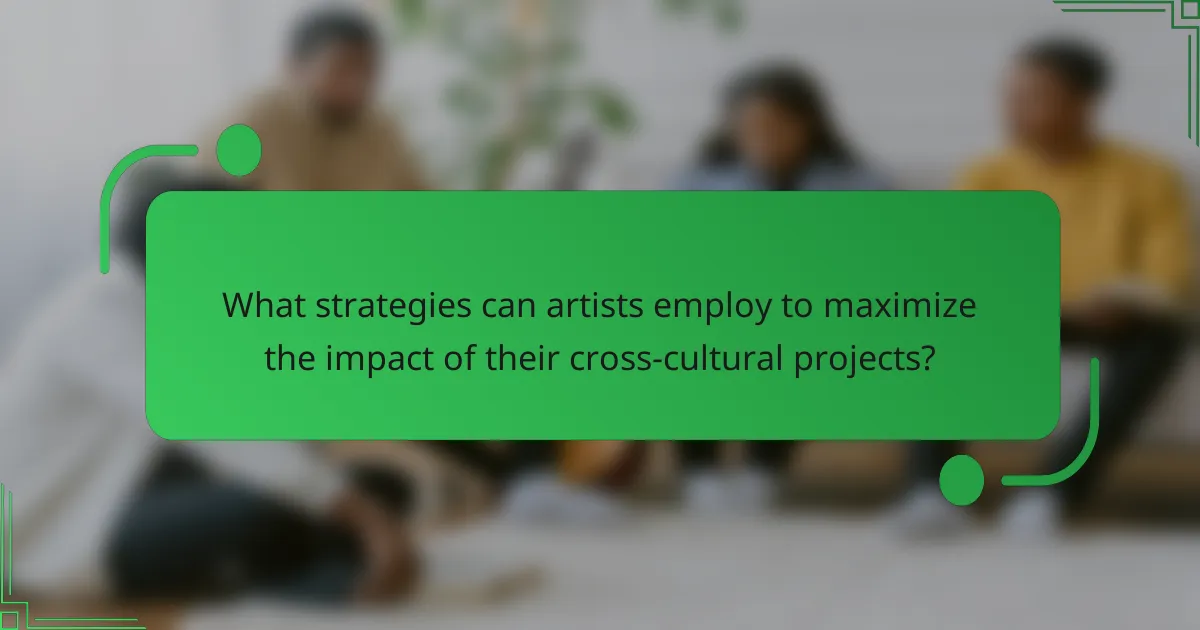
What strategies can artists employ to maximize the impact of their cross-cultural projects?
Artists can maximize the impact of their cross-cultural projects by fostering authentic collaborations, engaging with local communities, and utilizing digital platforms effectively. Building partnerships with artists from different cultures enhances creativity and broadens audience reach. Active community involvement ensures cultural sensitivity and relevance, while digital tools can amplify visibility and facilitate global connections. Success stories often highlight the importance of blending diverse musical styles and narratives, creating unique experiences that resonate with varied audiences.
How can networking enhance opportunities for collaboration?
Networking enhances opportunities for collaboration by connecting diverse talents and resources. It fosters creativity and innovation through cross-cultural exchanges in indie music projects. Collaborations can lead to unique sounds and broader audiences. For instance, artists from different backgrounds can merge distinct musical styles, resulting in fresh, impactful creations. This synergy often leads to increased visibility and success stories that resonate globally.
What are the best practices for navigating cultural sensitivities in music creation?
To navigate cultural sensitivities in music creation, prioritize respect and understanding of diverse backgrounds. Engage with local artists to gain insights into their cultural narratives.
Foster open communication throughout the collaboration process. Acknowledge and incorporate cultural elements authentically, ensuring that representations are accurate and respectful.
Research the cultural significance of musical styles and themes to avoid misrepresentation. Create a feedback loop with collaborators to address concerns and refine the project.
Establish clear agreements on how cultural elements will be used, ensuring mutual consent. This approach enhances collaboration and leads to more impactful and respectful music projects.
Which common mistakes should artists avoid in cross-cultural collaborations?
Artists should avoid misunderstandings, cultural appropriation, and lack of communication in cross-cultural collaborations. Misunderstandings can arise from differing cultural norms and expectations. Cultural appropriation can alienate collaborators and audiences. Effective communication ensures clarity and respect for diverse perspectives.



